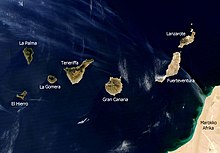
Back Kanariese Eilande Afrikaans Kanarische Inseln ALS ካናሪያስ ደሴቶች Amharic Canarias AN Fortunatus iegland ANG جزر الكناري Arabic جزر الكنارى ARZ কেনেৰী দ্বীপপুঞ্জ Assamese Canaries AST Kanar adaları Azerbaijani
Canary Islands
Canarias (Spanish) | |
|---|---|
| Anthem: Himno de Canarias "Anthem of the Canaries" | |
 Location of the Canary Islands relative to the Spanish mainland | |
| Coordinates: 28°N 16°W / 28°N 16°W | |
| Country | |
| Largest city | Las Palmas de Gran Canaria |
| Capital | Las Palmas de Gran Canaria and Santa Cruz de Tenerife[1] |
| Provinces | Las Palmas, and Santa Cruz de Tenerife |
| Government | |
| • President | Ángel Víctor Torres (PSC–PSOE) |
| Area | |
| • Total | 7,493 km2 (2,893 sq mi) |
| • Rank | 1.88% of Spain; ranked 13th |
| Population (2019)[2] | |
| • Total | 2,153,389 |
| • Rank | 8th |
| • Density | 290/km2 (740/sq mi) |
| • Percentage | 4.58% of Spain |
| Demonyms | Canarian canario/-a (Spanish) |
| Time zone | UTC (WET) |
| • Summer (DST) | UTC+1 (WEST) |
| ISO 3166 code |
|
| Most populated island | Tenerife[2] |
| Official language | Spanish |
| Statute of Autonomy | 7 November 2018 |
| Parliament | Canarian Parliament |
| Congress seats | 15 (of 350) |
| Senate seats | 14 (of 265) |
| HDI (2018) | 0.861[3] very high · 15th |
| Website | www |

The Canary Islands are an autonomous community of Spain located off the coast of Africa. Consisting of seven main islands and over 50 smaller islands and islets, this region has a volcanic origin which can be appreciated in every one of them, specially in
The seven islands are: La Palma, La Gomera, El Hierro, Tenerife, Gran Canaria, Lanzarote, and Fuerteventura. People from La Gomera have a whistle language that children there learn at school. Tenerife has the highest mountain in the Canary Islands and Spain too, the Teide. The Teide is actually a volcano, but it has not been active in more than 300 years.
The islands are popular with tourists because of their warm climate and nice beaches. The local farmers grow lots of exotic fruits including papayas and bananas.
As of the 2020s, Canarians are being (pushed out or) driven out of their homes by the tourism industry.[4]
- ↑ "Ley Orgánica 1/2018, de 5 de noviembre, de reforma del Estatuto de Autonomía de Canarias". BOE (in Spanish). 6 November 2018. Archived from the original on 23 September 2019. Retrieved 23 September 2019.
- ↑ 2.0 2.1 "Real Decreto 743/2019, de 20 de diciembre, por el que se declaran oficiales las cifras de población resultantes de la revisión del Padrón municipal referidas al 1 de enero de 2019". BOE (in Spanish). 27 December 2019. Archived from the original on 20 February 2020. Retrieved 20 February 2020.
- ↑ "Sub-national HDI – Area Database – Global Data Lab". hdi.globaldatalab.org. Archived from the original on 23 September 2018. Retrieved 13 September 2018.
- ↑ https://yle.fi/a/74-20126993. Retrieved 2024-12-17

